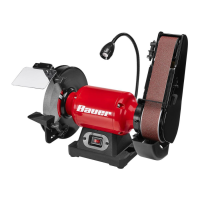Page 13For technical questions, please call 1-888-866-5797.Item 58871
SAFETYOPERATIONMAINTENANCE SETUP
5. Slide a new 2" x 28" Sanding Belt (sold separately)
onto the front and rear Drums with the directional
arrows on the inside of the Belt pointing in the
direction of rotation as indicated on the tool.
6. Center the Belt correctly on both Drums.
Push the Tension Lever down to tighten
the Belt to the Sanding Arm.
7. Replace the Sanding Belt Cover and
tighten the Cap Screw securely.
8. Before using, check the new Sanding
Belt for alignment. Refer to Adjusting
Sanding Belt Tracking on page 10.
Troubleshooting
Problem Possible Causes Likely Solutions
Tool will not start. 1. Cord not connected.
2. No power at outlet.
3. Tool’s thermal reset breaker
tripped (if equipped).
4. Internal damage or wear.
(Carbon brushes or power
switch, for example.)
1. Check that cord is plugged in.
2. Check power at outlet. If outlet is unpowered,
turn off tool and check circuit breaker.
If breaker is tripped, make sure circuit is right
capacity for tool and circuit has no other loads.
3. Turn off tool and allow to cool.
Press reset button on tool.
4. Have qualified technician service tool.
Tool operates slowly. 1. Forcing tool to work too fast.
2. Extension cord too long or cord
diameter too small.
3. Applying too much pressure
while grinding or sanding.
1. Allow tool to work at its own rate.
2. Eliminate use of extension cord. If an
extension cord is needed, use one with
the proper diameter for its length and load.
See Extension Cords on page 6.
3. Use less pressure.
Performance
decreases over time.
Carbon brushes worn or damaged. Have qualified technician replace brushes.
Excessive noise
or rattling.
Internal damage or wear. (Carbon
brushes or bearings, for example.)
Have qualified technician service tool.
Overheating. 1. Forcing tool to work too fast.
2. Blocked motor housing vents.
3. Motor being strained by long or
small diameter extension cord.
1. Allow tool to work at its own rate.
2. Wear ANSI‑approved safety goggles and
NIOSH‑approved dust mask/respirator while
blowing dust out of motor using compressed air.
3. Eliminate use of extension cord. If an
extension cord is needed, use one with
the proper diameter for its length and load.
See Extension Cords on page 6.
Wood burns
while sanding
1. Sanding Belt may be loaded
with dirt or debris.
2. Applying too much
pressure while sanding.
1. Clean or replace Sanding Belt using
instructions in this manual.
2. Use less pressure.
Follow all safety precautions whenever diagnosing or servicing the tool.
Disconnect power supply before service.

